Tskaltubo, famous for its Abandoned Sanatoriums, was a favorite destination for people living in the Soviet World. Although, thousands of them were dreaming to get the pass to this glorious Spa resort. only the Leaders of the Soviet Party, the Political Elite and government members had gained the privilege.
Architecture of Tskaltubo, City of abandoned Sanatoriums
Certainly, One of the unique features of Tskaltubo’s wellness architecture is the emphasis on communal connection spaces. Both grand halls and serene gardens, these communal areas were strategically positioned to encourage social interaction, fostering a sense of community among guests. Imagine the lively conversations and shared moments that once filled these purposeful spaces.
Tskaltubo City has 3 rings.
- The first ring; baths or springs. There are 12 and numbered accordingly;
- The second ring; Abandoned Sanatoriums or hotels surrounding the spring area. 25 of them;
- The third ring; City settlement . population about —- people;
Springs
Springs in Tskaltubo were unique because of following factors:
- naturally warm, therefore no need to heat them.
- Intensity of the stream ; they don’t use pumps to transfer water;
- Composition; It’s been stable throughout the years, not losing any healing features.
Spring waters consist of Rodon elements which settle on the body during bath procedures, recommended duration 20-30 minutes a day. Each spring specialized in different kinds of treatment and Doctors used to prescribe patients to spend a specific amount of time in each of them accordingly. Full healthcare programs in Soviet times used to take up to 25 days.
Abandoned Sanatoriums
Sanatoriums had a concept of wellness hotels. As people were staying in Tskaltubo for nearly a month, Sanatoriums used to have not only medical profile, but entertaining programs as well . In some of the Abandoned Sanatoriums theater, Movie theater, a library and conference is still possible to find. They also had a doctor’s unit for consulting visitors about which spring to visit. (at Sanatoriums there were no hot springs).
At Soviet Times the specific ministry used to finance construction of a Sanatorium. As a result , names, ex: Miner, Metallurgist referred to their “Parent” industry. Generally, the price of a Tskaltubo Spa course was not expensive; about 120 rubles, though not available for everybody. Mainly Soviet party members, Factory administration, political elite used to reserve them, thus hardly available for ordinary citizens.
The settlement or Tskaltubo city
In fact, apartments, private houses, markets and pharmacy shops, belonging to city infrastructure, surround the main area of the resort. Therefore visitors who were not lucky enough to have a pass to sanatoriums, used to settle in this area. Rent was main income of locals at Soviet time. There are no abandoned Sanatoriums in the living districts of Tskaltubo.
Legends and Stories
As you wander through the echoing corridors, listen closely to the whispers of the past. The walls, adorned with remnants of frescoes and forgotten murals, bear witness to the vibrant life that once thrived within. These whispers invite you to imagine the bustling energy that filled these spaces.
VII – XVIII centuries
Everything started with a legend, when a tired Shepard after a long time of wandering had entered the warm springs to relax. Certainly, it healed the shepherd’s injured legs. Shortly afterwards the spring area become known as Waters of Immortality. The first mention of Tskaltubo hot Springs appeared in VIII century chronicles as the Bathhouse operated by local Protoiereus. Lately, In the 12th century Gelati Monastery gains the authority over the springs . Furthermore, according to historical records, in the 13th century, King Tamar’s warriors were intensively visiting springs for curing . Til the end of 18th century, in the light of perpetual war, Tskaltubo disapears in Chronicles . It reappears again in European Healthcare publications from the end of the 18th century. According to one of the interpretations, Tskaltubo means water area. Specifically, ‘’Tskali’’ in Georgian means water, ‘’Tube’’ – area or a territory.
Tskaltubo at the end of 19th and beginning of 20th century
According to local magazines, private companies were managing the springs by the time. Though infrastructure was not well maintained; there were no doctors available at site and major health threats presented. No control or supervision over visitors. Diseased and healthy people were not isolated and sometimes even shared a bath altogether. At the place of Abandoned Sanatoriums there were small, one room cotteges, serving as a living space for patients. The entrance fee for the bath used to cost 0.20 ruble per procedure and 1 ruble a day to rent a room near the Springs.
Another big problem for Tskaltubo at that time was that the River used to enter the spring area, mixing with spring waters and creating a swamp in the central part of the city.
Consequently, In 1920, realizing the healthcare risks, the government expropriated the springs and started developing the infrastructure. As a result Bathhouses were reconstructed, clinics were built and doctors started examining patients. In 1927 Tskaltubo get electricity and a meteorological station. In 1935 they built a channel around the Springs area and isolated the river from the central part. The area was dried and became more convenient for further developments. In the same year the railway connected Tskaltubo to other cities of the Soviet Union.
From 1950, there began the era of grand architectural projects in Tskaltubo, which made the spa resort famous not only throughout the Soviet Union, but beyond it’s borders. Staying in Tskaltubo became a symbol of success and privilege. Only people with connections could acquire a pass to the Spas.
Tskaltubo’s Abandoned Sanatoriums in 90’s and after
In the 90’s the Soviet Union collapsed. Must be remembered, that The Soviet Economy worked like one big system andit’s failure in all of the republics created a plethora of economic and political crises. For Georgia, that meant war in Abkhazia (Region of Georgia) and the civil war. And thus, commenced the darkest times in the recent history of Georgia.
Georgia, buried in civil war, crime and poverty, thus no longer appealed to travelers. Consequently, Golden Era of Grand Sanatoriums disappeared in the Dark of the Nineties (In Georgia this period of time is referred to as the Dark Nineties). Furthermore, Tskaltubo had become a ghost town. Georgian families who escaped the war in Abkhazia, found their shelters in the abandoned Sanatoriums. At the time of crises the government had no resources to maintain these amazing structures. They were robbed and destroyed many times.
In contrast, early 2000’s marked the start of a new political era in Georgia. The new president initiated grand infrastructure projects in Georgia, including Tskaltubo, which was fully renovated. Consequently, the Government offered all Sanatoriums for sale. At the moment some of the Sanatoriums were reconstructed and started accepting visitors. Some of them were sold and conserved. Others are still abandoned waiting for potential investors.
About Safety while visiting Abandoned Sanatoriums
All of the buildings in our blog, are safe to visit. Structures are strong, though you need reasonable caution while walking around. Sanatoriums itself are abandoned, but they are surrounded by a living city. So, you may encounter locals having photography sessions, who are friendly and helpfull.
Era of Grand Sanatoriums of Tskaltubo
Step into the fascinating world of Tskaltubo’s wellness architecture, where every curve, corridor, and chamber was meticulously designed to enhance visitors’ health. The interiors boast a blend of classic and modern elements, creating an atmosphere of sophistication and comfort. From art deco details to minimalist aesthetics, each sanatorium tells a unique design story that adds to the overall charm of the wellness experience.
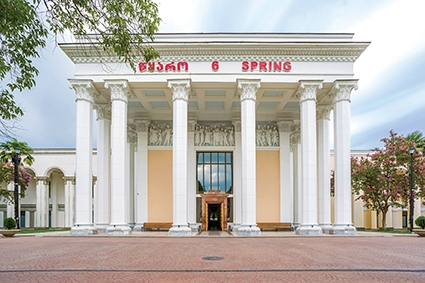
Spring N 6 or Stalin’s Bath
Spring N 6 or Stalin’s Bath started functioning in 1951. Undoubtedly, it’s the biggest and the most comfortable bath in Tskaltubo. There are 50 individual baths and three pools. The building is furnished with marble, ceramic and wood. The lux cabin of the Spa is believed to have been used by Stalin personally. Original decorations are still kept at site. Spring N 6 is a functioning spa.
Spots to visit:
- The fountain and the monument in front of a Spring. The monument depicts an old legend about the fight between a young warrior and the lion.
- Main hall of the spa. Not reconstructed, only repainted showcasing the authentic style of Soviet times. The vase in the center of the hall, was a present to the administration of the Spa on the 40th year anniversary of communism in Georgia;
- The main pool is located at the end of the main hall. Decorations and furnishing are authentic.
- To the right in the corridor there is another pool. People believes, that it was a personal space of Stalin. Decorations are fully authentic.
Current status: free to visit

Bath N 5

100 meters away from Spring N 8, at the park there is an abandoned public Bath. It’s architecture is unique. Under the huge dome there are 6 sections equally distributed around the main ring of the structure. In each individual sector there are small bathtubs surrounding a hot fountain, connected to Spring N 6. At the opposite, Spring N 6 was a private bath, where each individual tube has isolated space, likewise in Hotels. This Bath, however, was public with individual baths sharing the main space.
Current status: free to visit
Abandoned Sanatoriums – Medea
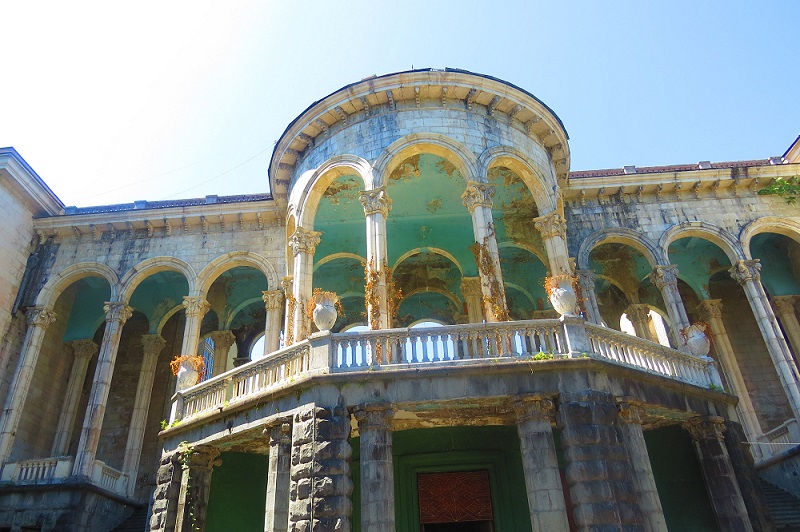
Designers of Sanatorium Medea became Georgian Architects, Instkirveli and Fotskishvili. It started functioning in 1962. Exterior of the Sanatorium was decorated with white stone and the interior was furnished by marble. By the time Sanatorium Medea could receive 325 visitors and. price for a 20 day stay amounted to 130 rubles. It’s medical profile was General. The Name of Sanatorium derives from the Legend about a Golden Fleece. Medea was a healer and a daughter of Mythological Kolkhetian King Aieti. Kolkheti was an ancient kingdom on the territory of Western Georgia starting from 7th century B.C.
Main Spots:
- Main hall with colonnade;
- Reception under main hall;
- Left wing with a small fountain – left turn to the trail before going up to colonnade;
- Restaurant and cafeteria – you may reach it with left side corridor entering from colonnade;
- Terrace above colonnade – you may go up the stairs from the left or a right side corridor;
Current status: Medea, one of the most beautiful abandoned Sanatoriums, is free to visit.
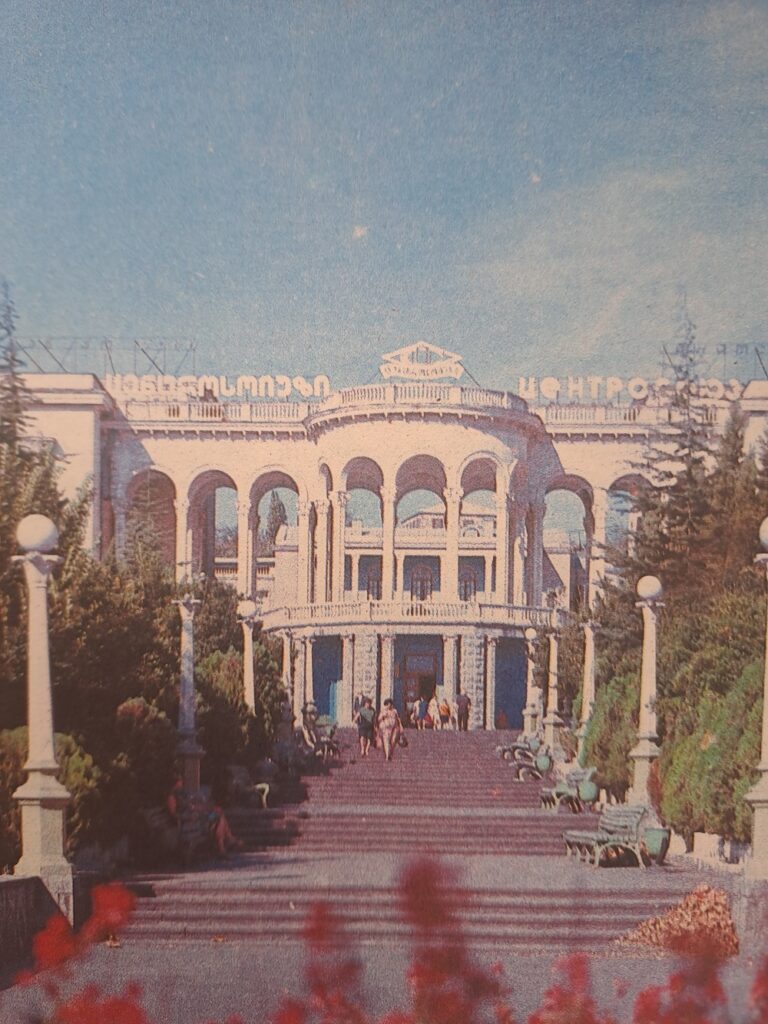
Abandoned Sanatoriums – Metalurg
As in case of other Sanatoriums of 60-es, the design of Metalurg, was a result of cooperation of Georgian and Russian Architects. The construction of the complex started in 1950 and became available for visitors in 1957. Metalurg’s healthcare profile was skeletal and muscle system and could accept 276 visitors. By the time price for a 20 day stay with a healthcare package was 140 Rubles.

Interesting Spots:
- Main hall with Chandalier. It’s possible to go to upper floors;
- Library and Theater in the left Wing;
- Restaurant and cafeteria in the right wing;
Current status: free to visit
Abandoned Sanatoriums – Shakhter
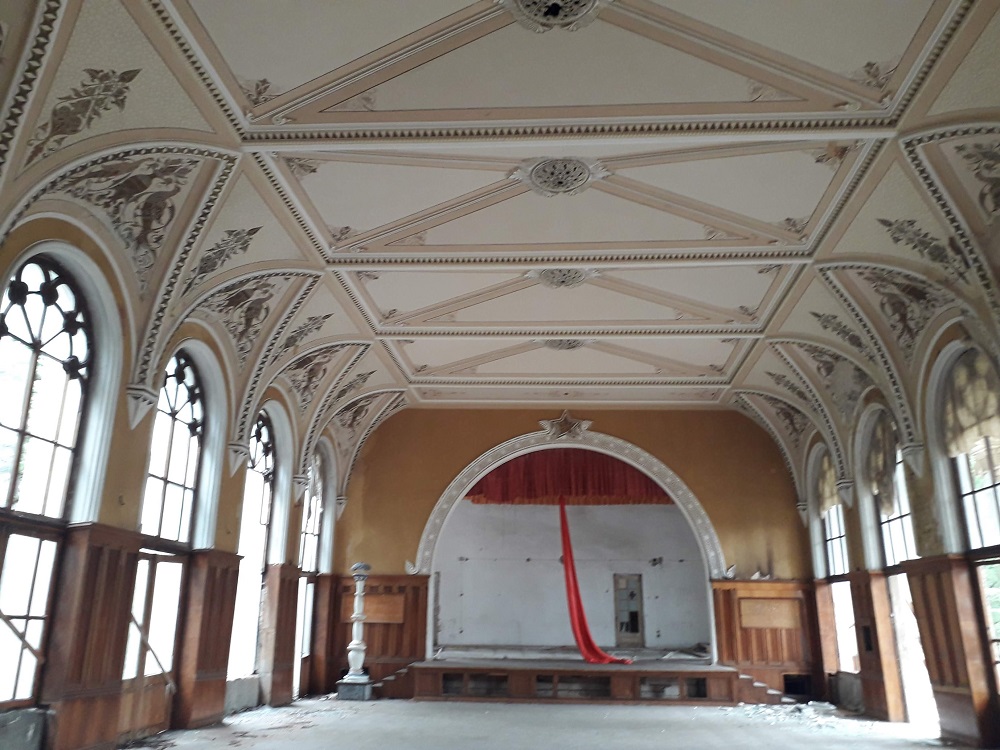
Georgian and Russian Architects Khimshiashvili and Melegi were the authors of Shakhter’s amazing design. . It became available for visitors in 1952. Shakhter could accept up to 350 visitors. Price of a 20 day stay including healthcare was 140 Rubles. It’s main medical profile was the cardiovascular system.
Interesting spots:
- Gorgeous Theater in the left wing on the 3rd floor;
- Retaurant on 2d floor;
- Meeting room furnished in woods at the end of right wing;
- Roof terrace at the end of a right wing;
Current status: Sanatorium owns private company. Thus, the most impressive one from abandoned Sanatoriums, is almost impossible to enter.
Sanatorium Tbilisi

Sanatorium Tbilisi or Resort Hotel, as refereed to in Soviet times, opened it’s doors 1951. The sanatorium could accept 302 visitors. It’s main healthcare profile was muscle and skeletal system. Price of a 20 days stay and healthcare program was 140 Rubles.
Spots to visit:
- Frontal part of the hotel and the entrance guarded by phoenixes;
- Backyard garden;
- Main Hall on upper hall;
- Roof terrace with beautiful views over Tskaltubo;

Abandoned Sanatoriums – Imereti
Sanatorium Imereti was designed by Georgian Architects Djanelidze and Meskhishvili. The construction of Imereti started in 1950 and it became available for visitors in 1961. Imereti could accept 305 visitors. Price of a 20 day stay including the healthcare program was 140 Rubles. Its main healthcare profile was the neurological system.
main spots to visit:
- Main hall of the Sanatorium with impressive staircase architecture;
- Restaurant in the left wing with 3 tiers of arches;
- Movie theater on the second floor, above the restaurant;
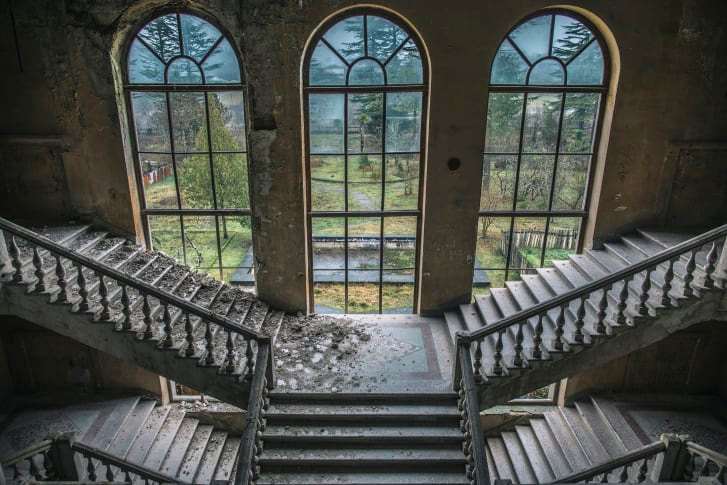
Current status: Abandoned Sanatorium Imereti is free to enter. Though some part of it’s amazing structure is not accessible, because of ruined roofs.
Abandoned Sanatoriums – Gelati
Designers of Sanatorium Gelati, were Russian Architects Poliudova and Abramova. Initially it was the second block of the Sanatorium Metalurg. Construction started in 1953 and from the year 1967 it became autonomous and received the name of Gelati. It was the only Sanatorium for mothers and children. Cost of the pass for a mother and a baby was 320 rubles. Gelati could accept 220 visitors. Its main healthcare profile was the neurological system.


interesting sites to visit:
- Main hall of Sanatorium;
- Yard between blocks;
- Playground;
Abandoned Sanatoiums – Sakartvelo
Undoubtedly, Sakartvelo, was the biggest out of all Sanatoriums in the area and could accept 500 visitors. Construction started in 1974 and became open to visitors in 1983. The concept of the buildings doesn’t seem very interesting. Though reaching the top floor gives you extreme feeling of being in another dimension, overlooking the whole resort. Meeting the sunset here is an amazing option to finish your urban adventure at abandoned Sanatoriums of Tskaltubo.



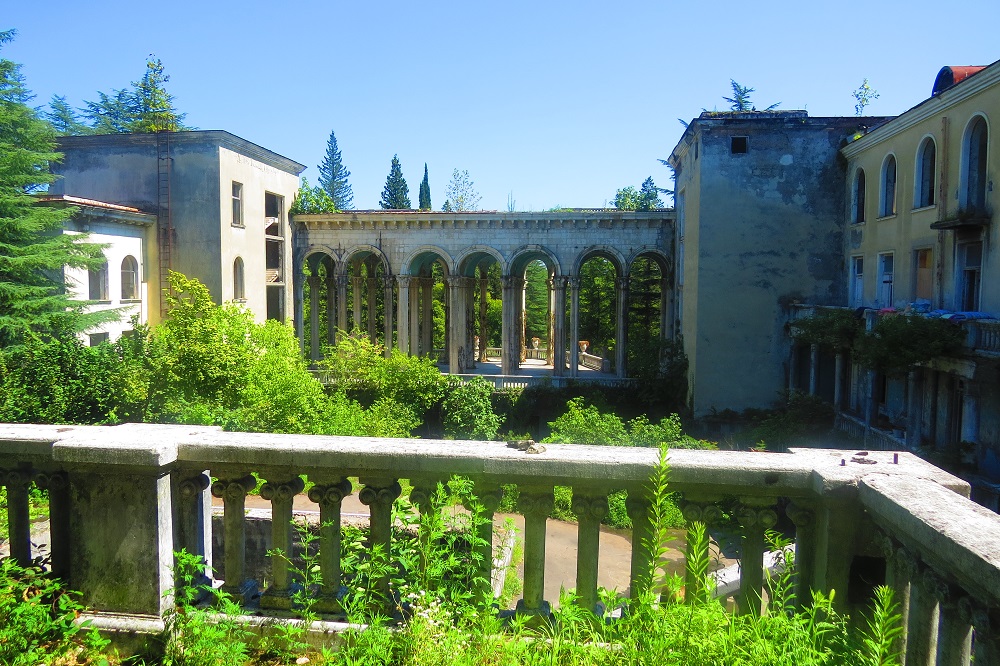







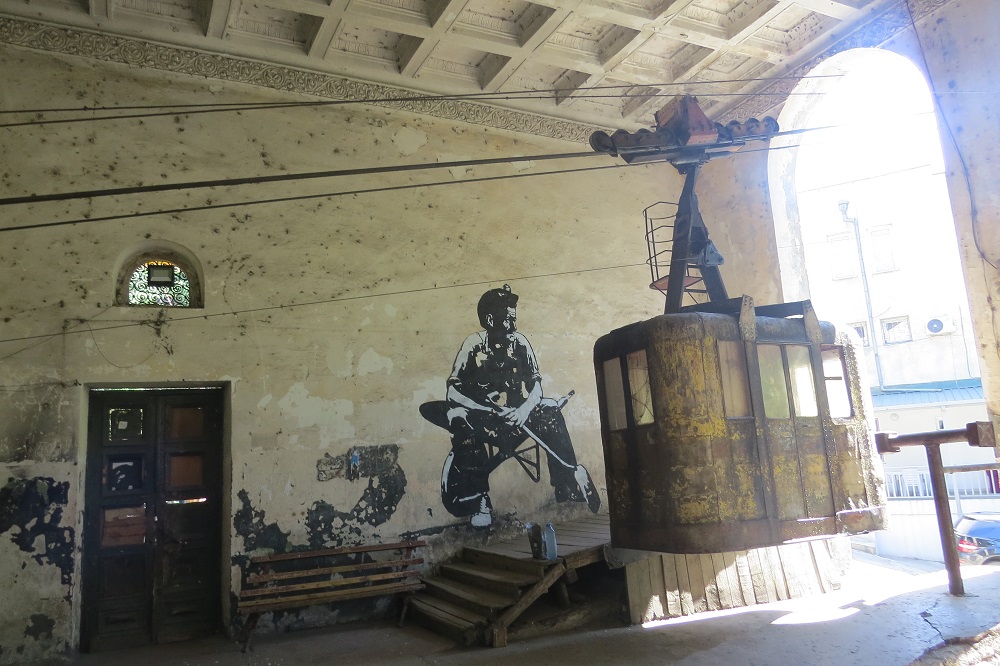
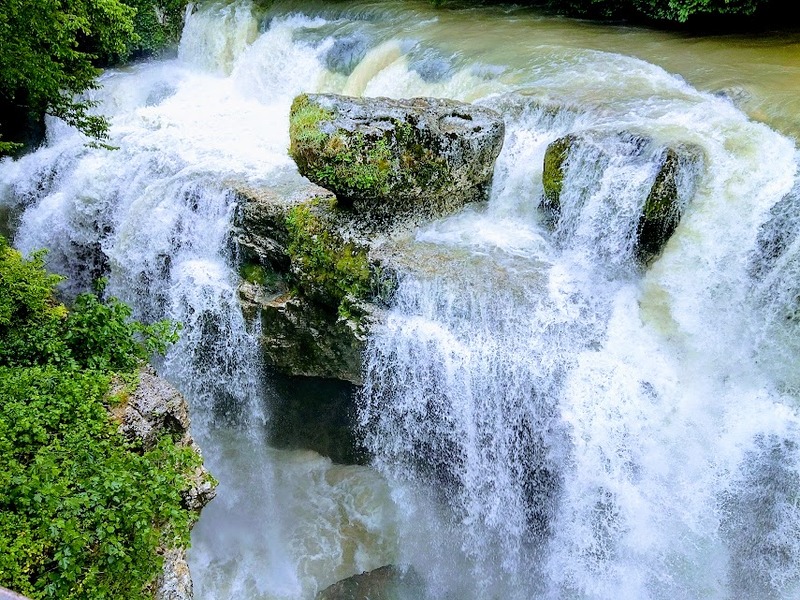

One thought on “Guide to Exploring Abandoned Sanatoriums of Tskaltubo”